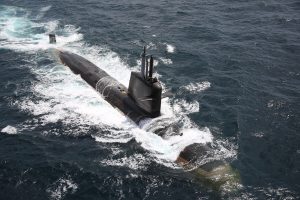The Philippines military is keen on acquiring more anti-ship missiles and at least two submarines as part of its ongoing modernization program, the commander in chief of the Armed Forces of the Philippines (AFP) said yesterday.
In a speech to leading business figures in Taguig City yesterday, Gen. Romeo Brawner Jr. reaffirmed the AFP’s longstanding ambition to acquire a submarine fleet in order to better defend its dispersed maritime geography.
“It’s a dream for us to get at least two submarines,” Brawner said in the speech, according to a report by the Inquirer. “We are an archipelago. So we have to have this type of capability, because it’s really difficult to defend that entire archipelago without submarines.”
He also flagged the purchase of additional BrahMos anti-ship missiles from India, following the $375 million purchase of three BrahMos missile batteries in early 2022, the first of which was delivered last April. “We are getting more of this (system) this year, and in the coming years,” Brawner said, as per Reuters.
BrahMos, which has been developed by BrahMos Aerospace, a joint venture between India and Russia, is the world’s fastest supersonic cruise missile. It can be launched from submarines, ships, aircraft or from land platforms, and flies at nearly three times the speed of sound, making it nearly impossible for targets to evade.
In February of last year, President Ferdinand Marcos Jr. approved a supplemented modernization plan aimed at bolstering the military’s naval, aerial, and surveillance assets, and completing its shift from a land army focused on internal threats to a naval and air force better able to defend the Philippines’ large territorial waters and exclusive economic zone. Known as Re-Horizon 3, the plan represented an updated version of Horizon 3, the final stage of a three-phase modernization initiative that began in 2013. Under this plan, Manila plans to spend up to 2 trillion pesos ($35 billion) over the next decade to upgrade its military capabilities and safeguard its claims in the South China Sea.
The Philippines’ military build-up has been spurred by the ongoing tensions between Manila and Beijing in the South China Sea, which has seen a string of confrontations and clashes between the two sides in recent years.
In his speech yesterday, Brawner cited the “increase in China’s illegal, coercive, aggressive, and deceptive activities” in the West Philippine Sea, as Manila refers to its portion of the South China Sea. “We have seen an increase also in the number of vessels in the West Philippine Sea on a daily basis. From 190 vessels in 2021, now we see 286 on the average daily for the year 2024,” he added.
One of the AFP’s main partners so far has been the South Korean shipbuilder Hyundai Heavy Industries, which has already delivered a pair of Jose Rizal-class frigates to the Philippine Navy. Manila has also purchased two missile corvettes from Hyundai, which are expected to be delivered this year, as well as six offshore patrol vessels. South Korea also donated a Pohang-class corvette to the Philippine Navy in 2019.
Submarines would represent a significant upgrade to the Philippine Navy’s capabilities. The AFP has desired a submarine capability for years, although until recently it was unclear whether it could afford the cost of purchasing and maintaining a submarine fleet. But the plan seems set to come to fruition under Re-Horizon 3, which has allocated a budget of 80 billion to 110 billion pesos (between 1.38 billion and $1.89 billion) to the acquisition of two submarines and the associated basing and logistical requirements.
The most likely partner would be France’s Naval Group, which has offered to sell two Scorpène-class submarines to the Philippines, which would be based at the former U.S. naval base in Subic Bay, and the training of the personnel needed to operate them.
Given the continued pressure that China continues to place on the Philippines’ outmatched and overburdened navy and coast guard, it would be no surprise if there were a firmer announcement about a possible submarine procurement in the months or years to come.

































